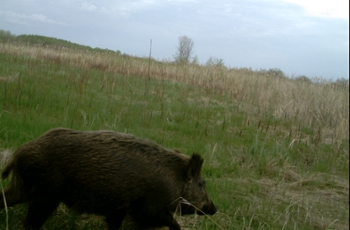
U of S researcher warns of growing wild boar infestation in Saskatchewan
Wild boar are more widespread in Saskatchewan than commonly believed and the need to control numbers of the destructive animals is becoming urgent, according to research by University of Saskatchewan biologist Ryan Brook.
By Jennifer Thoma"If nothing is done then we risk having more feral boar than people in the province, and at that point the costs of taking action are far greater," Brook said. "Early action will have huge economic savings."
Brook, together with colleague Floris van Beest from Aarhus University in Denmark, surveyed community leaders in all 296 Saskatchewan rural municipalities in what they believe is the first peer-reviewed scientific study of the animals in Canada.
From these local reports, they determined there is a high probability that feral wild boar exist in 70 percent of the province's rural municipalities-- and the clock is ticking on getting them under control.
"Feral wild boar are widespread but most likely at low densities. So as of right now, total impacts are probably generally low," Brook said. "The big concern is what will happen in the near future if the boar population continues to expand and increase."
Wild boar, imported as an alternative livestock option for farmers in the 1990s, have easily adapted to Saskatchewan's harsh climate where they are able to not only survive but reproduce. Wild boar have one of the highest reproductive rates of any large animal, with sows producing two litters of six or more piglets every year.
Omnivorous and aggressive, their rooting behaviour leaves parks, farmers' fields and sensitive wildlife habitat looking like a rototiller has gone through. THey chase livestock from pasture, carry disease, and can pose a danger to humans. Areas in and near Moose Mountain Provincial Park in southeast Saskatchewan are a particular hot spot. There, local ranchers and farmers have banded together to hunt the animals in a formal eradication program.
"I think many people in Saskatchewan are not aware of how severe the impacts of feral boar can be," Brook said. "In the U.S., the impacts are in the billions of dollars from disease, crop damage, livestock harassment, impacts on natural ecosystems and species at risk, and attacks on humans."
Brook and van Beest also observed that control plans are spotty and sporadic across the country, and call for "aggressive and coordinated action" to meet the threat. Brook explained that sport hunting has no real impact on controlling population growth and in many cases makes the problem worse by dispersing animals. Instead, an international effort is needed. Authorities need to consider options such as hunting from aircraft, at night, using trained dogs, ground trapping and on-farm risk management.
"We'll probably need all of these in the tool box to be reasonably effective," Brook said. "All regions need to address this in a coordinated fashion or animals will continue to be re-introduced from other areas."
Brook and van Beest's research paper appears in the Wildlife Society Bulletin. Funding for the work was provided by the National Sciences and Engineering Research Council of Canada, the Cyril Capling Trust Fund and the U of S.

